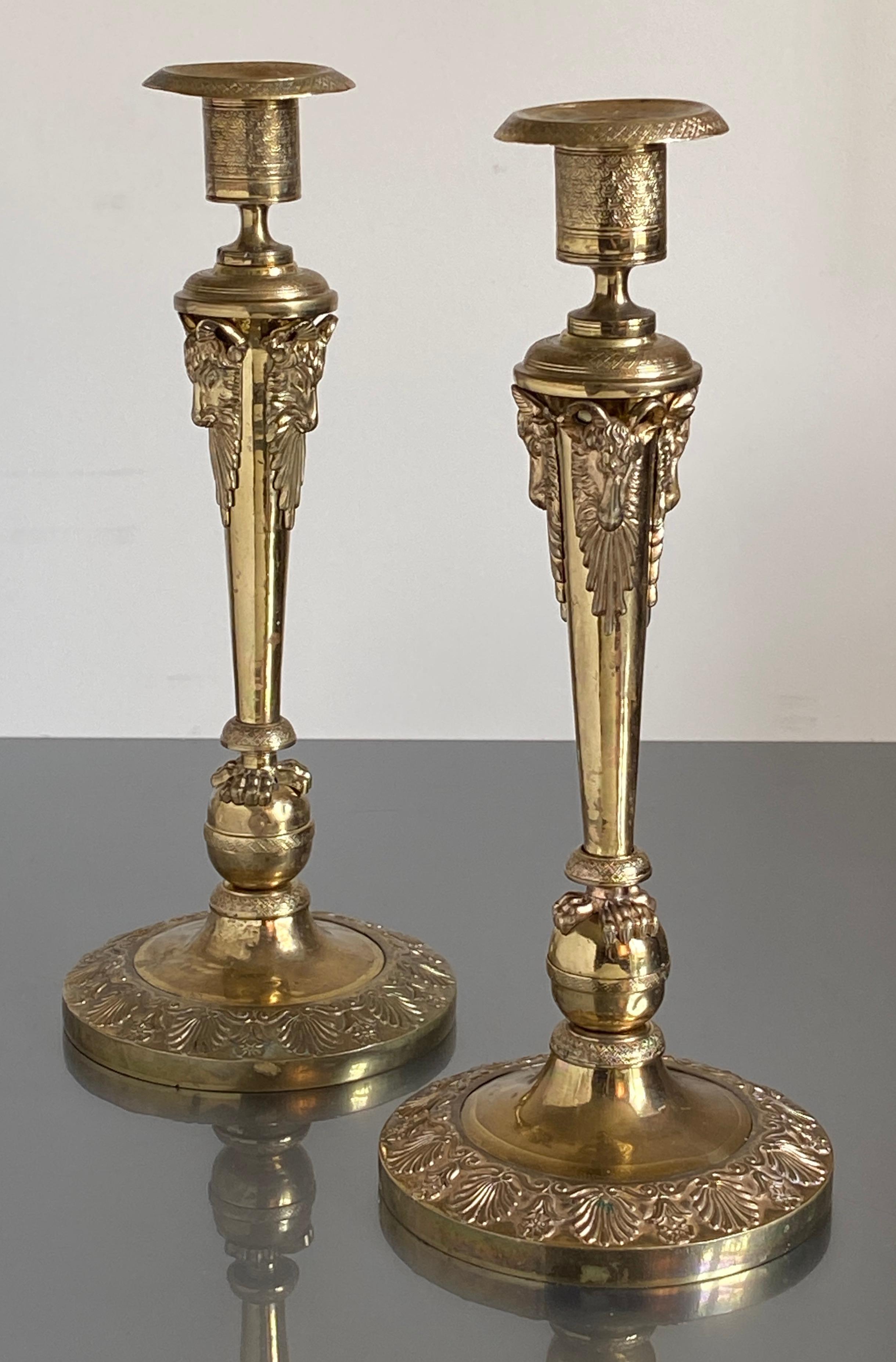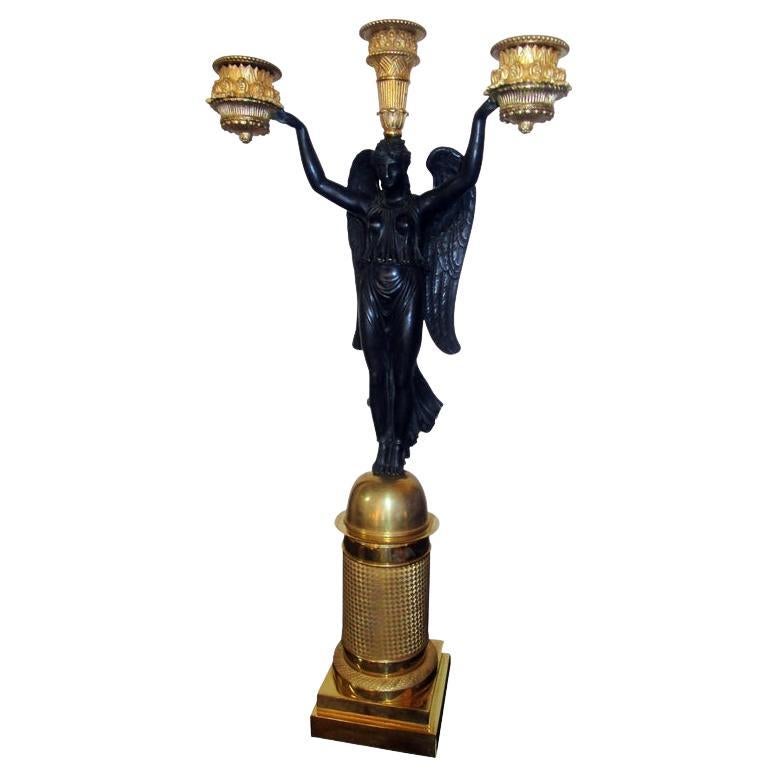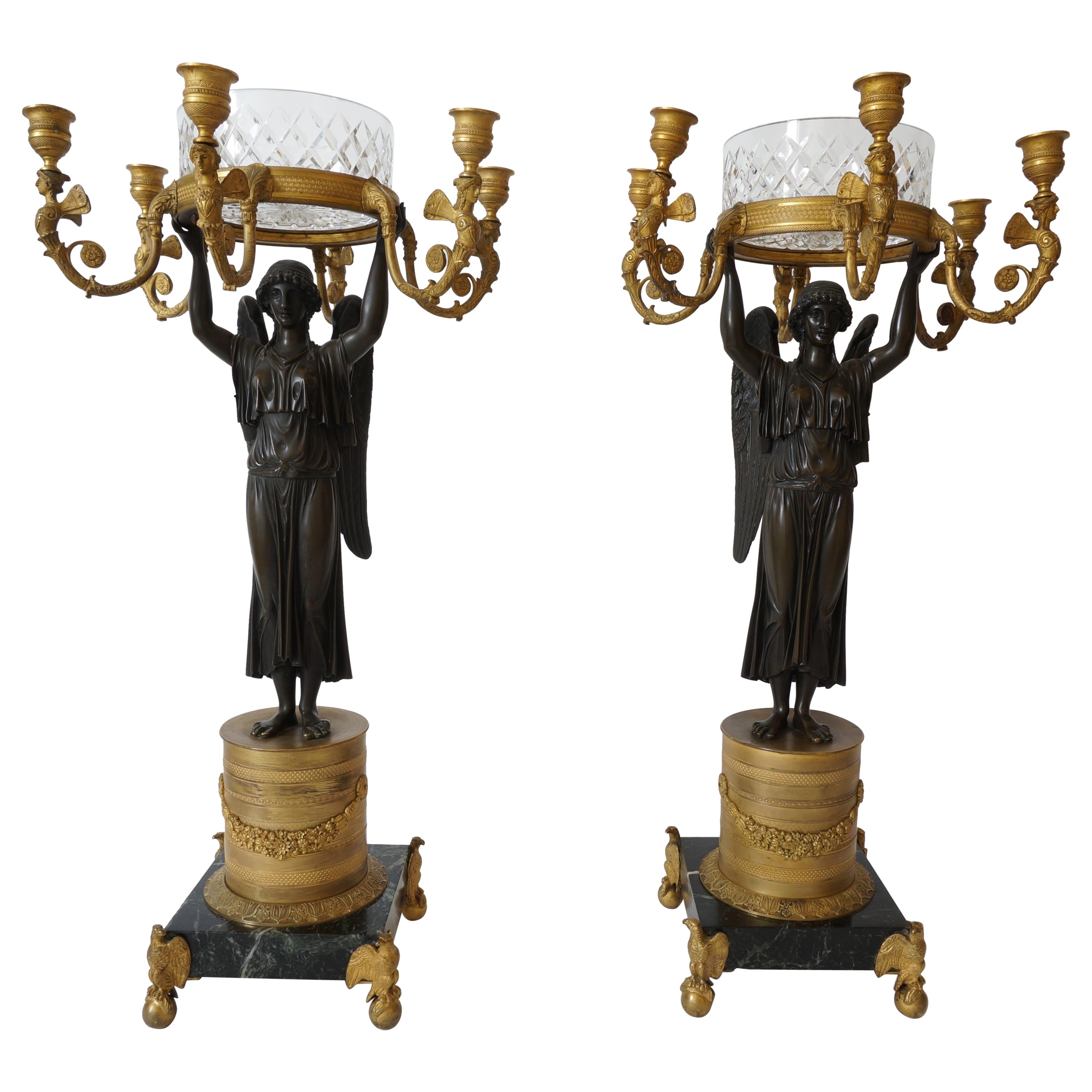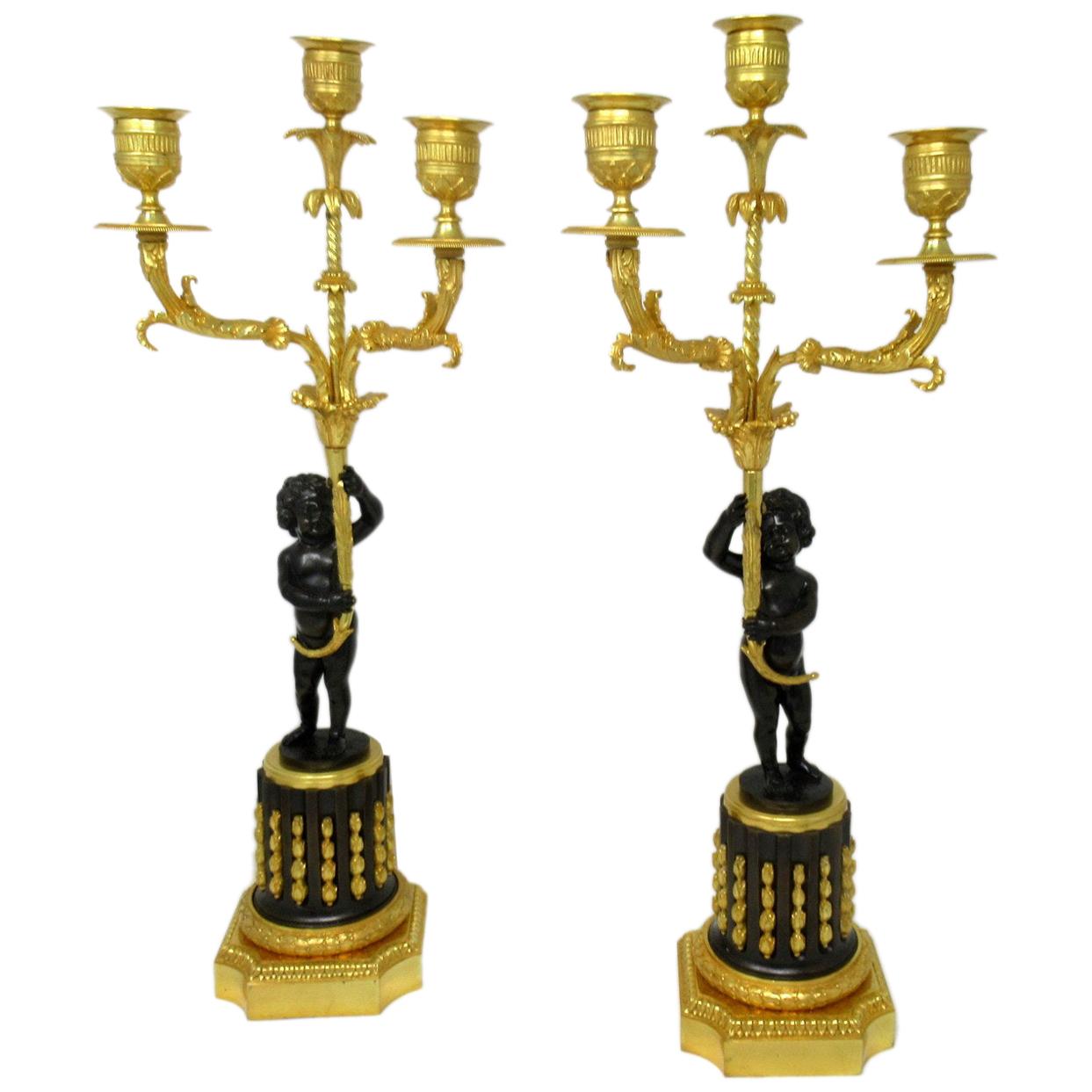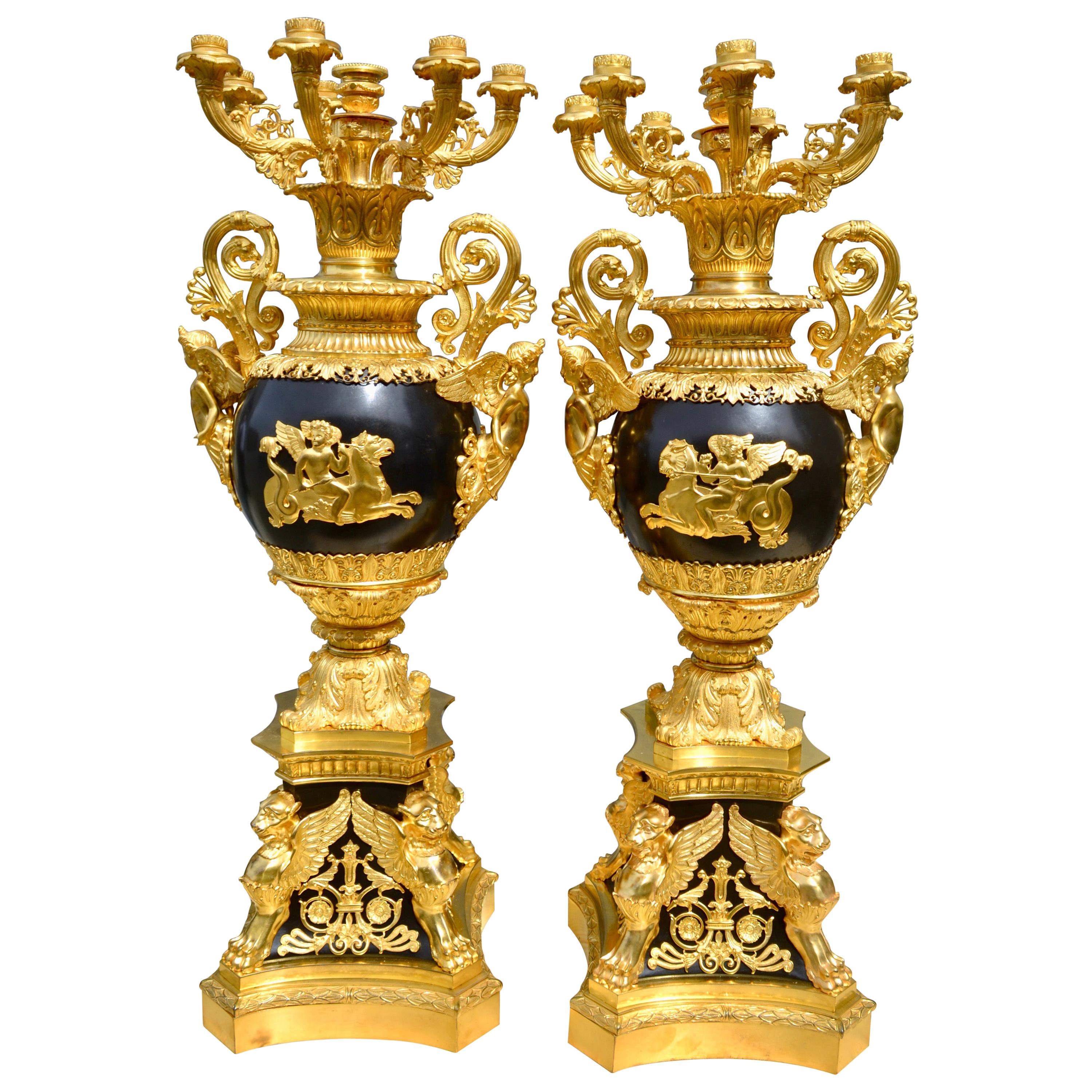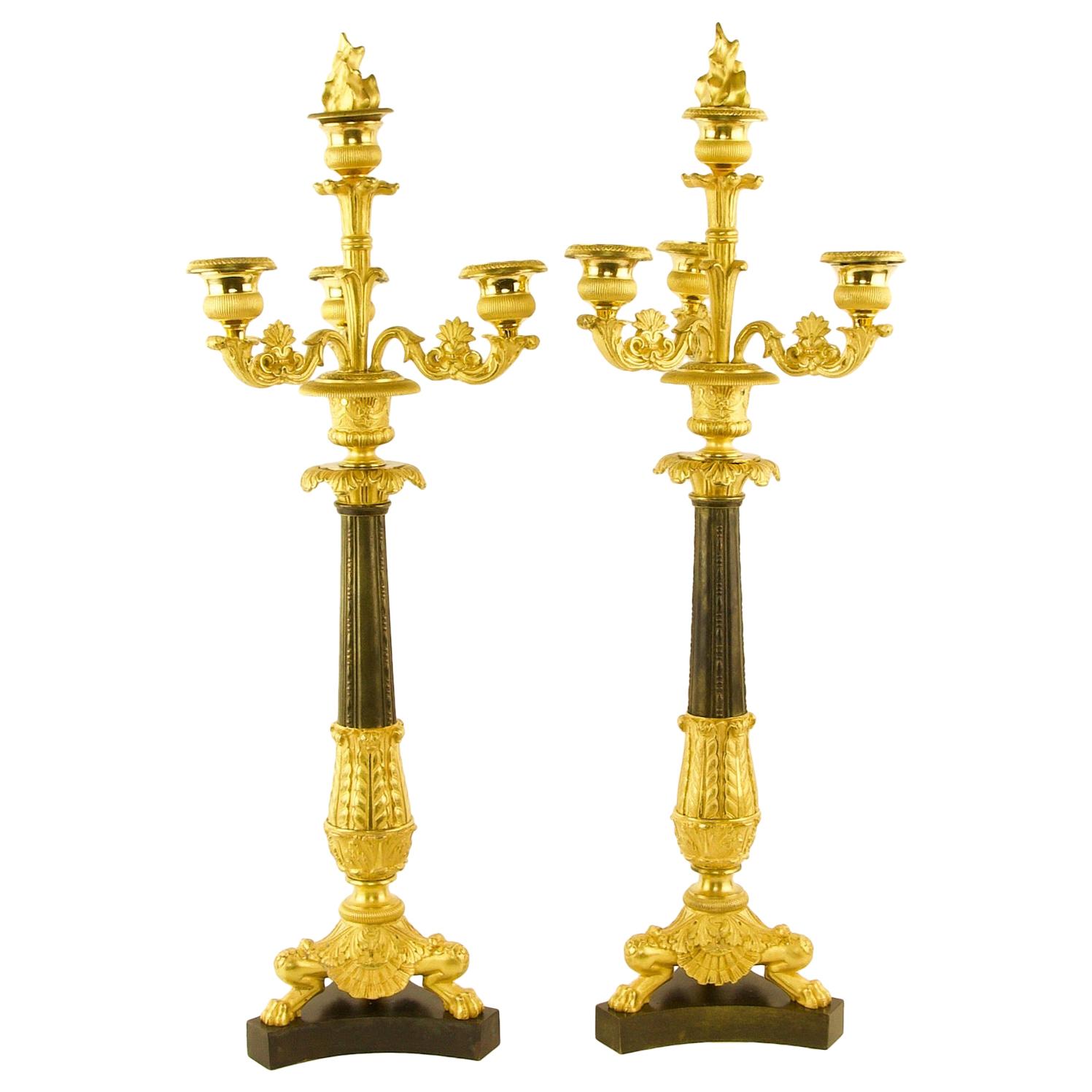Items Similar to French Empire Candelabra Apollo & Daphne Manner of Pierre-Philippe Thomire
Want more images or videos?
Request additional images or videos from the seller
1 of 21
French Empire Candelabra Apollo & Daphne Manner of Pierre-Philippe Thomire
About the Item
From our Sculpture collection, we are delighted to offer this fine pair of French Empire Candelabra. The Candelabra exceptionally cast as an opposing pair of Apollo and Daphne. The stepped plinth bases beautifully executed with Swan neck corners above foliate scrollwork with a central column surmounted by minerva (Sulis Minerva). The column bases are mounted with an ormolu sphere which acts as a base to each bronze figure. Each figure holds a lyre which transforms into a five branch candelabra from a bouquet of blossoming flowers. The Candelabra are truly in the manner of Pierre-Philippe Thomire and quite possibly attributed to the French metalworking master. The pair of Candelabra date to the French Empire period which was an in the early 19th century ruled by Napoleon I 1804 to 1814.
Apollo (Phoebus) is the Greek god of healing, archery, music and arts, sunlight, knowledge, and patron of Delphi. Regarded as a great warrior and as the most beautiful of the gods.
Daphne is a nymph or huntress of Artemis. Her parentage varies, depending on the source, but it’s generally understood that her father is a river god Peneus (Ladon) and her mother was either the nymph Creusa (Gaia).
Apollo and Daphne the story takes place right after the great snake that terrorised mankind is slain by Apollo. Apollo pierced the Python with 1,000 arrows and then founded the sanctuary of Delphi atop of the Python’s dead body. This sanctuary became home to the famous oracle, Pythia, and the sacred Pythian Games were held to celebrate his victory. The winners were, at first, honoured with oak wreaths, since the laurel didn’t yet exist. Apollo goes onto spot Daphne in the woodlands and immediately falls in love with her however, Daphne took an oath of virginity and begged her father Peneus to abide by her choice, eventually after complying Peneus goes onto tell his daughter it would be near impossible for her daughter to not marry and have children due to her Devine beauty.
Daphne flees from Apollo taking him as a predator, Apollo explains that he wishes to pursue her as a lover in which Daphne rejects Apollo continually. Eros assists Apollo by giving him wings to pursue his lover and then hangs onto Daphne’s shoulders in an attempt to slow her gait. They were soon within sight of her father’s waters. Exhausted, overcome by the efforts of her escape, and sensing that she was about to be caught, Daphne ran toward the banks and cried out in aid from her father the river god “Help me father! If your streams have divine powers change me, destroy this beauty that pleases too well!” Daphnes call for aid was answered and Peneus transformed Daphne into the Laurel Tree.
Even in this state, Apollo could not help but love her. In spite of Daphne’s clear terror and fervent insistence that he leaves her be, Apollo vowed to honour her forever. He says that he will wear her leaves in his hair, will use her wood to make his bow and lyre, and that a crown made of her branches will adorn the heads of royalty and champions of game and battle.
French Empire (The First French Empire) or officially the French Republic and then the French Empire after 1809 was the empire ruled by Napoleon Bonaparte, who established French leadership over much of continental Europe from 1804 to 1814 and again very briefly in 1915.
Ormolu is the technique of applying finely ground, high-carat gold–mercury amalgam to an object of bronze. The mercury is driven off in a kiln leaving behind a gold coating. The French refer to this technique as bronze doré and in English it is often referred to as gilt bronze. It is a finishing technique which adds an overall gold look to any object without the massive cost and impracticality of making an object out of solid gold. Mercury was outlawed in the 1830’s in France however it was still used until the early 1900s.
Bronze an alloy consisting primarily of copper with approximately 12–12.5% tin and often with the addition of other metals (including aluminium, manganese, nickel, or zinc) and sometimes non-metals, such as phosphorus, or metalloids such as arsenic or silicon depending on the age of the bronze and its origin. The additions of other metals produce a range of alloys that are usually harder than copper alone and carry useful properties such as strength. The earliest known use of bronze dates to the 5th millennium BCE from Iranian plateau, the bronze mix consists of arsenical copper and copper-arsenide. The earliest tin-copper-alloy recovered is dated to circa 4650 BCE and was found in Plocnik, Serbia. It is believed to have been smelted from a natural tin-copper ore.
Lyre a stringed musical instrument part of the lute-family and consists of two arms and a crossbar with strings. The Lyre has featured on classical objects like the pair of vases above for thousands of years. They were commonly used in several ancient cultures surrounding the Mediterranean Sea. The earliest known examples of the lyre have been recovered at archaeological sites that date to c. 2700 BCE in Mesopotamia.
Measurements (centimetres) 67cm High x 25cm Wide x 20cm Deep
- Similar to:Pierre-Philippe Thomire (Maker)
- Dimensions:Height: 26.38 in (67.01 cm)Width: 9.84 in (25 cm)Depth: 7.87 in (19.99 cm)
- Style:Empire (Of the Period)
- Materials and Techniques:
- Place of Origin:
- Period:
- Date of Manufacture:Circa 1810
- Condition:Wear consistent with age and use.
- Seller Location:Newark, GB
- Reference Number:
About the Seller
5.0
Vetted Seller
These experienced sellers undergo a comprehensive evaluation by our team of in-house experts.
Established in 2019
1stDibs seller since 2022
17 sales on 1stDibs
Typical response time: 3 hours
- ShippingRetrieving quote...Ships From: Newark, United Kingdom
- Return PolicyA return for this item may be initiated within 14 days of delivery.
More From This SellerView All
- French Pair of Louis XIV Style Ormolu Candelabra Henry DassonBy Henry DassonLocated in Newark, EnglandFrench Late Bronze Dore From our Decorative collection, we are delighted to introduce this French Pair of Louis XIV Style Ormolu Candelabra by Henry Dasson. The pair of candelabra b...Category
Antique Late 19th Century French Louis XIV Candelabras
MaterialsMetal, Ormolu, Bronze
- Oversized Georgian Barley Twist Candle SticksLocated in Newark, Englandfine and very unusual large pair of English open barley twist candle sticks. The candle sticks of extraordinary Size with a beautiful dark b...Category
Antique Early 19th Century English Georgian Candlesticks
MaterialsWood
- French Cranberry Glass BoxLocated in Newark, EnglandFrench Cranberry Glass Box. The box of oval form with chamfered lid and brass mounts decorated throughout with a central band of enamelled greek ke...Category
Antique Late 19th Century French Napoleon III Decorative Boxes
MaterialsBrass
- French Champlevé Onyx BoxBy Ferdinand BarbedienneLocated in Newark, EnglandFine 19th century French champlevé and onyx jewellery casket. The casket of rectangular form with four corner pillars, hinged lid and painted panel. The casket decorated extensively ...Category
Antique Late 19th Century French Napoleon III Decorative Boxes
MaterialsBronze, Enamel
- French 'Sevres' Porcelain BoxBy Manufacture Nationale de SèvresLocated in Newark, EnglandA large sized ‘Sevres‘ porcelain box. The box decorated with a base of cobalt blue with gild scrollwork decoration throughout. The lid featuring a large painted panel with a classica...Category
Antique Early 1900s French Napoleon III Ceramics
MaterialsCeramic, Porcelain
- French Bronze Ariadne After ClodionBy Claude Michel ClodionLocated in Newark, EnglandSigned Clodion From our Sculpture collection, we are pleased to offer this French Belle Epoque Bronze of Ariadne cast after Clodion (Claude Michel). The sculpture of fine casting and beautiful patination is sculpted as a bust of a Ariadne in nature with her hair tied up and leaves intwined in her hair. The Bronze sits upon a circular socle with a square base signed to the right hand face Clodion. The Bronze cast after the original during the neoclassical era dating to the second half of the 19th century during the Belle Epoque era (c.1970-1914) circa 1875. Clodion was the alias of Claude Michel (1738-1814) a French born sculptor working in the Rococo style, especially noted for his works in marble, bronze, & terracotta. Many of Clodion’s works feature in museum collections around the world with some of his most pivotal works including The Intoxication of Wine and The Dance of Time. Ariadne In Greek mythology was a Cretan princess and the daughter of King Minos of Crete. Ariadne was known for aiding Theseus escape the Minotaur and then being abandoned by him on the island of Naxos. There, Dionysus saw Ariadne sleeping, fell in love with her, and later married her. Many versions of the myth recount Dionysus throwing Ariadne’s jewelled crown into the sky to create a constellation, the Corona Borealis...Category
Antique Late 19th Century French Belle Époque Busts
MaterialsBronze
You May Also Like
- Russian Empire Gilt Bronze Candlesticks in the manner Pierre-Philippe ThomireBy Pierre-Philippe ThomireLocated in Cheltenham, GBA Pair of Russian Empire gilt bronze candlesticks produced in France / Russia around 1810 in the manner of Pierre-Philippe Thomire Of substantial size and expertly cast in matt and ...Category
Antique Early 19th Century Russian Empire Candlesticks
MaterialsBronze
- Pierre-Philippe Thomire Attributed Single French Empire Gilt Bronze CandelabrumBy Pierre-Philippe ThomireLocated in Savannah, GAA very fine single French Empire style gilt bronze three-light candelabra featuring the allegorical "à la Victoire". The winged figure holds aloft in her out stretched arms two intricately designed candle-wells in the form of baskets, with an additional basket overhead. She stands balanced on an embossed cylinder over a double plinth with a squared base. This piece is for the serious collector passionate about finely handcrafted decorative arts with superior craftsmanship. It is flawlessly cast and highly detailed, take notice of the folds of her dress that seem to fly in the wind. Done in the distinct manner of Pierre Philippe Thomire (French, 1751-1843) after the original design by Charles Percier...Category
Antique 1810s French Empire Candelabras
MaterialsBronze
- Pair of Empire Candelabra Thomire StyleBy Pierre-Philippe ThomireLocated in West Palm Beach, FLAntique Thomire style 6-candle candelabra epergne gilded and patina bronze with cut crystal bowl on dark green marble with eagle mounts from a Palm Beach...Category
Antique Mid-19th Century French Empire Candelabras
MaterialsCrystal, Marble, Bronze
- French Regency Empire Ormolu Bronze Candelabra Pierre-Philippe Thomire, PairLocated in Dublin, IrelandStunning rare pair of French empire ormolu and patinated bronze three light candelabra. First quarter of the 19th century, possibly Regency period. Attributed to Pierre-Philippe T...Category
Antique 19th Century French Regency Candlesticks
MaterialsBronze, Ormolu
- Palatial Pair of French Empire Style Candelabra after ThomireBy Pierre-Philippe ThomireLocated in Vancouver, British ColumbiaThe candelabra are of gilt and patinated bronze of very high quality. They are basically deisgned/constructed in three sections. The middle section; the patinated central vases have twin handles in the form of decorative winged cupids, the front of the vase has a large gilded bronze mount of a winged cupid riding a lion/dolphin. The 'lid' of the vase supports seven swirling candle arms around a central stem topped with a flame. The elaborate base of the vase rests on a further very elaborate rectangular base with winged lions at each corner. It is hard to imagine a more elaborate and grandiose example of the French Empire decorative...Category
Antique Late 19th Century French Empire Revival Candelabras
MaterialsBronze
- Pair of 19th Century Empire Ormolu and patinated Bronze Candelabra attr. ThomireBy Pierre-Philippe ThomireLocated in Berlin, DEPair of 19th century Empire ormolu and patinated bronze candelabra attr. Thomire Each with a tapering leaf tip cast partially gilt and patinated bronze stem supporting three folia...Category
Antique 1820s French Empire Candelabras
MaterialsBronze, Ormolu
Recently Viewed
View AllMore Ways To Browse
19th C French Dore Bronze
First Empire France
Solid Gold Candelabra
Antique String Holder
Wreath Cast
Candle Holder Tree Metal
1830s Candelabra
Bronze Candelabras With Flowers
Candelabra With Five Candle Holders
French Gilt Candelabra Flowers
French Republic
Wide Candelabra
Gold Flower Candle Holders
Tea Leaves Holder
Danish Designer Candle Holders
Retro Wooden Candle Sticks
Bronze And Gold Candelabra
Four Light Bronze Candelabra
